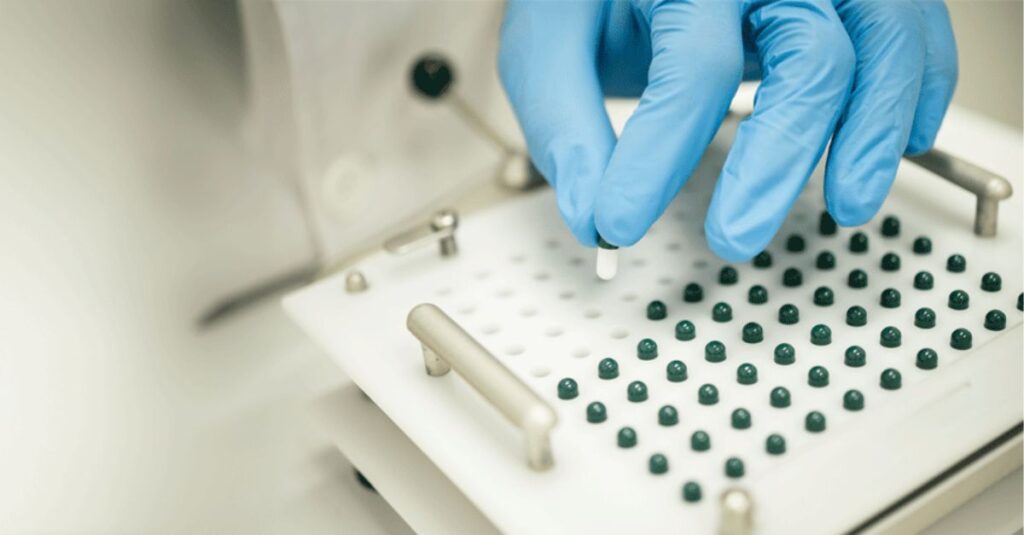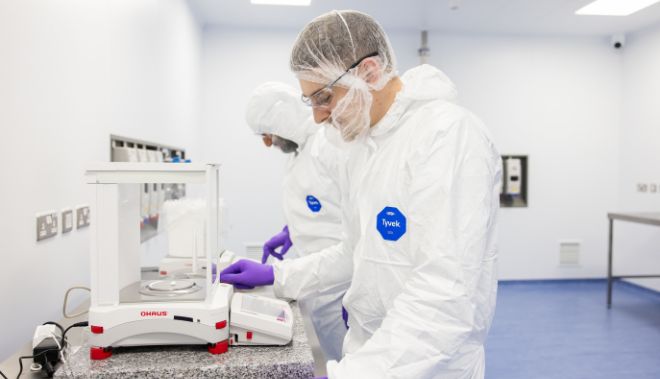Introduction to Oral Solid Dosage Forms
Oral solid dosage (OSD) forms, like tablets and capsules, are the most common drug delivery methods. They are popular due to patient preference, ease of manufacturing, and cost efficiency. Optimising each stage of the OSD manufacturing process is essential to ensure product quality, efficiency, and cost-effectiveness. Automation and robotics are increasingly shaping OSD manufacturing, reducing human error and improving efficiency. Small pharmaceutical companies can also benefit from partnering with Contract Development and Manufacturing Organisations (CDMOs), which offer expertise and resources to streamline development and production.
Upon ingestion, OSD forms undergo disintegration and dissolution in the gastrointestinal tract, followed by absorption of the active pharmaceutical ingredient (API) into the bloodstream to exert the intended therapeutic effect.
The Basics of Oral Solid Dose Manufacturing
Tablets and capsules are the most widely used OSD forms. Their advantages include manufacturing efficiency, cost savings, and patient convenience. Understanding the OSD manufacturing process helps pharmaceutical companies deliver safe and high-quality medicines. When you take an OSD product, it disintegrates and dissolves in the gastrointestinal tract, allowing the active pharmaceutical ingredient (API) to absorb into the bloodstream and work as intended.


Tablets and Capsules Explained
Tablets and capsules are the most widely used OSD forms. Their advantages include manufacturing efficiency, cost savings, and patient convenience. Understanding the OSD manufacturing process helps pharmaceutical companies deliver safe and high-quality medicines. When you take an OSD product, it disintegrates and dissolves in the gastrointestinal tract, allowing the active pharmaceutical ingredient (API) to absorb into the bloodstream and work as intended.
Capsules consist of a two-part shell made of gelatin or a polymer, which contains the drug product. The contents can be in powder, granule, or liquid form. Capsules offer various release profiles and are often chosen based on drug stability, release characteristics, and patient preferences.
Key Stages in Oral Solid Dose Manufacturing.
Transforming a drug substance into a market-ready OSD product involves meeting strict quality, safety, and efficacy standards. Every stage, from pre-formulation studies to packaging, requires control and optimisation.
1) Pre-Formulation and Formulation Development
The foundation of successful OSD manufacturing starts with pre-formulation and formulation development. This stage focuses on understanding the physicochemical properties of the API, such as: solubility, stability, particle size, and flow characteristics.
Once you have this information, you move to the formulation stage. Here, you select excipients—inactive ingredients that support the API’s stability, processability, and bioavailability (the rate and extent to which the API absorbs into the bloodstream).
The formulation stage also determines the drug’s release profile, considering factors like therapeutic goals, patient demographics, and manufacturing challenges.
2) Granulation Techniques: Wet vs Dry
Granulation is the process of grouping dry powders into larger granules to improve flow properties and compressibility. There are two main methods: wet granulation and dry granulation.
Dry Granulation: This method uses mechanical pressure instead of liquid. It’s a better choice for moisture-sensitive APIs and shortens the manufacturing process, saving time.
Advantages of Dry Granulation:
- Suitable for moisture-sensitive drugs
- Fewer processing steps and less time required
Wet Granulation: This is the most common method. It uses a liquid binder to bind powder particles together, creating granules with better flow and compressibility. However, it may not be suitable for moisture-sensitive APIs.
Advantages of Wet Granulation:
- Better flow properties for tablet formation
- Enhanced compressibility for robust tablets
- Uniform distribution of the drug
3) Compression and Encapsulation: Tablets and Capsules
Compression: In tablet production, granules and excipients are subjected to high pressure to form solid tablets. Depending on your formulation, you can use direct compression or granulation followed by compression. Direct compression compresses a dry powder blend directly into tablets without prior granulation, offering cost and efficiency advantages but requiring good flow and compressibility properties.
Encapsulation: In capsules, the formulated powder or granules are placed into hard or soft shells. Hard capsules are more common and made of gelatin, consisting of two pre-formed halves that are filled and sealed. The choice between tablets and capsules depends on factors like drug stability, desired release profile, and patient preferences.
The Role of Automation and Robotics in OSD Production
Automation is integral to OSD manufacturing, affecting everything from material handling to packaging. It reduces manual work, lowers labour costs, and enhances process control, ensuring consistent product quality.
Robotics handle tasks such as equipment loading and unloading, material transfer, and packaging.
Robots offer more precision and repeatability than humans, ensuring accurate dosing and reducing contamination risks. This is critical for drugs with narrow therapeutic indices or those used by vulnerable patient groups.
Automated systems integrate with control processes, allowing real-time monitoring of critical parameters. This ensures regulatory compliance and enables quick detection and correction of any deviations.
Continuous Manufacturing
Continuous manufacturing (CM) differs from traditional batch processing. Instead of multiple steps with intermediate testing, CM integrates all processes into a continuous flow. This approach reduces manufacturing time, cuts operational costs, and improves product quality.
In CM, raw materials enter the system and are continuously processed into the final product, with real-time monitoring and adjustments to maintain quality. It eliminates intermediate hold times, minimising material losses and contamination risks.
CM also requires less physical space, as multiple processes can be combined in a single system. This saves space and reduces the need for extensive cleaning validation that often accompanies multiple equipment trains.
How CDMOs Streamline Development and Scale-Up
CDMOs provide specialised expertise to help you move from lab-scale development to pilot production and commercial-scale manufacturing. Their knowledge of OSD manufacturing processes ensures a smooth development transition.
CDMOs have access to advanced technologies like high-throughput screening platforms and continuous manufacturing lines. This allows small pharmaceutical companies to access capabilities they may not have in-house.
Collaborating with a CDMO reduces development timelines and the risks of bringing a new product to market. Their experience and resources help navigate regulatory requirements and manufacturing complexities, enabling a successful product launch.
Partnering with CDMOs
Small pharmaceutical companies face challenges in developing and bringing new drugs to market. Partnering with a CDMO with expertise in OSD manufacturing can be a strategic move.
CDMOs offer services that include:
- Formulation development
- Analytical testing
- Scale-up production
- Commercial manufacturing
These services allow small companies to focus on research and clinical development while the CDMO handles manufacturing and regulatory aspects. This collaborative approach speeds up development timelines and reduces risks tied to infrastructure investments and compliance requirements.
Selecting the Right CDMO Partner in the UK
Choosing the right CDMO is critical for your pharmaceutical project’s success. Reputation and track record matter when you trust a CDMO with your product. Look for CDMOs with:
- A history of successful projects
- Adherence to regulatory standards
- A commitment to product quality
The UK has a strong regulatory framework. Partnering with a CDMO that follows industry standards ensures a smooth drug development process.
Conclusion
Optimising the oral solid dose manufacturing process is essential for achieving efficiency, cost savings, and product quality. Partnering with a CDMO can provide significant advantages for small pharmaceutical companies, simplifying development and scaling up production. By choosing the right CDMO partner, you can enhance your OSD manufacturing capabilities and bring high-quality drug products to market more effectively.
Frequently Asked Questions
What are the most common challenges in OSD (oral solid dosage) production and packaging?
Common challenges include ensuring consistent quality of raw materials, maintaining batch-to-batch uniformity, preventing contamination, optimising drug dissolution and absorption, and achieving desired release profiles.
How can small pharma companies benefit from CDMOs in OSD (oral solid dosage) development?
CDMOs can support drug substance characterisation, develop suitable OSD forms, manufacture clinical trial materials under GMP standards, provide expertise in excipient selection, and support scale-up activities, ultimately saving time and costs.
How do regulations and guidelines impact the process of OSD (oral solid dosage) production?
Regulations and guidelines ensure the quality, safety, and efficacy of medications. Compliance with these standards is essential to meet industry requirements.